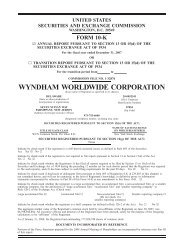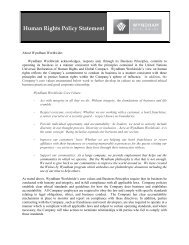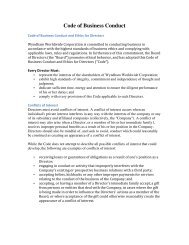WYNDHAM WORLDWIDE CORPORATION
WYNDHAM WORLDWIDE CORPORATION
WYNDHAM WORLDWIDE CORPORATION
Create successful ePaper yourself
Turn your PDF publications into a flip-book with our unique Google optimized e-Paper software.
on January 1, 2011, as required, and it believes the guidance will not have a material impact on the Company’s<br />
Consolidated Financial Statements.<br />
3. Earnings per Share<br />
The computation of basic and diluted earnings per share (“EPS”) is based on the Company’s net income/(loss)<br />
available to common stockholders divided by the basic weighted average number of common shares and diluted<br />
weighted average number of common shares, respectively.<br />
The following table sets forth the computation of basic and diluted EPS (in millions, except per share data):<br />
Year Ended December 31,<br />
2010 2009 2008<br />
Net income/(loss) $ 379 $ 293 $ (1,074)<br />
Basic weighted average shares outstanding 178 179 178<br />
Stock options and RSUs (a)<br />
4 3 —<br />
Warrants (b)<br />
3 — —<br />
Diluted weighted average shares outstanding<br />
Earnings/(losses) per share:<br />
185 182 178<br />
Basic $ 2.13 $ 1.64 $ (6.05)<br />
Diluted 2.05 1.61 (6.05)<br />
(a)<br />
(b)<br />
Includes unvested dilutive RSUs which are subject to future forfeitures.<br />
Represents the dilutive effect of warrants to purchase shares of the Company’s common stock related to the May 2009 issuance of the Company’s<br />
convertible notes (See Note 13 — Long — Term Debt and Borrowing Arrangements).<br />
The computations of diluted EPS for the years ended December 31, 2010, 2009 and 2008 do not include<br />
approximately 4 million, 9 million and 13 million stock options and stock-settled stock appreciation rights<br />
(“SSARs”), respectively, as the effect of their inclusion would have been anti-dilutive. Additionally, for the year<br />
ended December 31, 2009, the computation of diluted EPS does not include warrants to purchase approximately<br />
18 million shares of the Company’s common stock related to the May 2009 issuance of the Company’s Convertible<br />
Notes (see Note 13 — Long — Term Debt and Borrowing Arrangements) as the effect of their inclusion would have<br />
been anti-dilutive.<br />
Dividend Payments<br />
During each of the quarterly periods ended March 31, June 30, September 30 and December 31, 2010, the<br />
Company paid cash dividends of $0.12 per share ($86 million in the aggregate). During each of the quarterly periods<br />
ended March 31, June 30, September 30 and December 31, 2009 and 2008 the Company paid cash dividends of<br />
$0.04 per share ($29 million and $28 million in the aggregate during 2009 and 2008, respectively).<br />
Stock Repurchase Program<br />
On August 20, 2007, the Company’s Board of Directors authorized a stock repurchase program that enables it<br />
to purchase up to $200 million of its common stock. Under such program, the Company repurchased<br />
2,155,783 shares at an average price of $26.89 for a cost of $58 million and repurchase capacity increased<br />
$13 million from proceeds received from stock option exercises as of December 31, 2009. On July 22, 2010, the<br />
Company’s Board of Directors increased the authorization by $300 million. During 2010, the Company repurchased<br />
9,270,419 shares at an average price of $25.52 for a cost of $237 million and repurchase capacity increased<br />
$40 million from proceeds received from stock option exercises. As of December 31, 2010, the Company<br />
repurchased a total of 11,426,202 shares at an average price of $25.78 for a cost of $295 million under its current<br />
authorization and had $258 million remaining availability in its program.<br />
4. Acquisitions<br />
Assets acquired and liabilities assumed in business combinations were recorded on the Consolidated Balance<br />
Sheets as of the respective acquisition dates based upon their estimated fair values at such dates. The results of<br />
operations of businesses acquired by the Company have been included in the Consolidated Statements of Operations<br />
since their respective dates of acquisition. The excess of the purchase price over the estimated fair values of the<br />
underlying assets acquired and liabilities assumed was allocated to goodwill. In certain circumstances, the allocations<br />
of the excess purchase price are based upon preliminary estimates and assumptions. Accordingly, the allocations<br />
may be subject to revision when the Company receives final information, including appraisals and other analyses.<br />
Any revisions to the fair values during the allocation period, which may be significant, will be recorded by the<br />
Company as further adjustments to the purchase price allocations. Although the Company has substantially<br />
F-15







